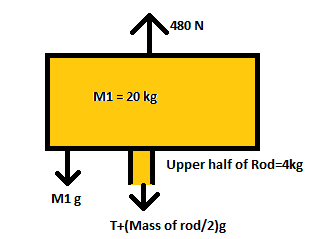
Two blocks of mass ${M_1} = 20kg$ and ${M_2} = 12kg$ are connected by a metal rod of mass $8kg$. The system is pulled vertically up by applying a force of $480N$ as shown. The tension at the midpoint of the rod is
(A) $144$
(B) $96$
(C) $240$
(D) $192$

Answer
219.6k+ views
Hint: We will first find the net acceleration of the entire system by applying Newton’s ${2^{nd}}$ Law on the whole rigid body. To find tension at the midpoint of the rod, we divide the whole system into two parts, splitting the rod, so that our first system becomes ${M_1}$ with half the rod, and the second system is the other half of the rod attached to ${M_2}$. Next we use Newton’s ${2^{nd}}$ Law to balance forces on the systems and find equations with tension at the mid-point of the rod $T$ as a variable. Using the previously calculated value of net acceleration of the system, we find the tension at the midpoint of the rod $T$.

Step by step solution: We know the acceleration of the system is $a$, where it can be found by applying Newton’s ${2^{nd}}$ Law on the system,
$480N - ({M_1} + 8 + {M_2})g = ({M_1} + 8 + {M_2})a$
$ \Rightarrow 480N = ({M_1} + 8 + {M_2})(a + g)$
$ \Rightarrow 480 = (20 + 8 + 12)(a + 10)$
$ \Rightarrow \dfrac{{480}}{{40}} = (a + 10)$
$ \Rightarrow a = 2m/{s^2}$

There, if the whole body is accelerating at $a = 2m/{s^2}$, then the upper half will also be accelerating at the same value of $a$
Let us assume the Tension as $T$ at the midpoint of the rod.
The net force on the first system is $480N - T - ({M_1} + 4)g = ({M_1} + 4)a$
Since the entire body is moving as a whole rigid mass with the same acceleration, here we will use the previously calculated value of $a = 2m/{s^2}$,
Therefore, since the upper half of the rod is of mass $4kg$, the equation becomes,
$ \Rightarrow 480 - T - ({M_1} + 4)g = ({M_1} + 4)2$
$ \Rightarrow 480 - T - (20 + 4)(10) = (20 + 4)2$
$ \Rightarrow 480 - (20 + 4)12 = T$
$ \Rightarrow T = 192N$
Hence option $(D)$ is correct
Note: Since the entire structure is a rigid body, the net acceleration of the system will be assumed to be uniform and the same both when the entire structure is being considered as a whole and also when the upper half of the rod and ${M_1}$ is considered.

Step by step solution: We know the acceleration of the system is $a$, where it can be found by applying Newton’s ${2^{nd}}$ Law on the system,
$480N - ({M_1} + 8 + {M_2})g = ({M_1} + 8 + {M_2})a$
$ \Rightarrow 480N = ({M_1} + 8 + {M_2})(a + g)$
$ \Rightarrow 480 = (20 + 8 + 12)(a + 10)$
$ \Rightarrow \dfrac{{480}}{{40}} = (a + 10)$
$ \Rightarrow a = 2m/{s^2}$

There, if the whole body is accelerating at $a = 2m/{s^2}$, then the upper half will also be accelerating at the same value of $a$
Let us assume the Tension as $T$ at the midpoint of the rod.
The net force on the first system is $480N - T - ({M_1} + 4)g = ({M_1} + 4)a$
Since the entire body is moving as a whole rigid mass with the same acceleration, here we will use the previously calculated value of $a = 2m/{s^2}$,
Therefore, since the upper half of the rod is of mass $4kg$, the equation becomes,
$ \Rightarrow 480 - T - ({M_1} + 4)g = ({M_1} + 4)2$
$ \Rightarrow 480 - T - (20 + 4)(10) = (20 + 4)2$
$ \Rightarrow 480 - (20 + 4)12 = T$
$ \Rightarrow T = 192N$
Hence option $(D)$ is correct
Note: Since the entire structure is a rigid body, the net acceleration of the system will be assumed to be uniform and the same both when the entire structure is being considered as a whole and also when the upper half of the rod and ${M_1}$ is considered.
Recently Updated Pages
Chemical Equation - Important Concepts and Tips for JEE

JEE Main 2022 (July 29th Shift 1) Chemistry Question Paper with Answer Key

Conduction Explained: Definition, Examples & Science for Students

Analytical Method of Vector Addition Explained Simply

Atomic Size - Important Concepts and Tips for JEE

JEE Main 2022 (June 29th Shift 1) Maths Question Paper with Answer Key

Trending doubts
JEE Main 2026: Application Form Open, Exam Dates, Syllabus, Eligibility & Question Papers

Understanding Uniform Acceleration in Physics

Derivation of Equation of Trajectory Explained for Students

Hybridisation in Chemistry – Concept, Types & Applications

Understanding the Angle of Deviation in a Prism

Understanding Collisions: Types and Examples for Students

Other Pages
JEE Advanced Marks vs Ranks 2025: Understanding Category-wise Qualifying Marks and Previous Year Cut-offs

Units And Measurements Class 11 Physics Chapter 1 CBSE Notes - 2025-26

NCERT Solutions For Class 11 Physics Chapter 8 Mechanical Properties Of Solids

Motion in a Straight Line Class 11 Physics Chapter 2 CBSE Notes - 2025-26

NCERT Solutions for Class 11 Physics Chapter 7 Gravitation 2025-26

Mechanical Properties of Fluids Class 11 Physics Chapter 9 CBSE Notes - 2025-26




